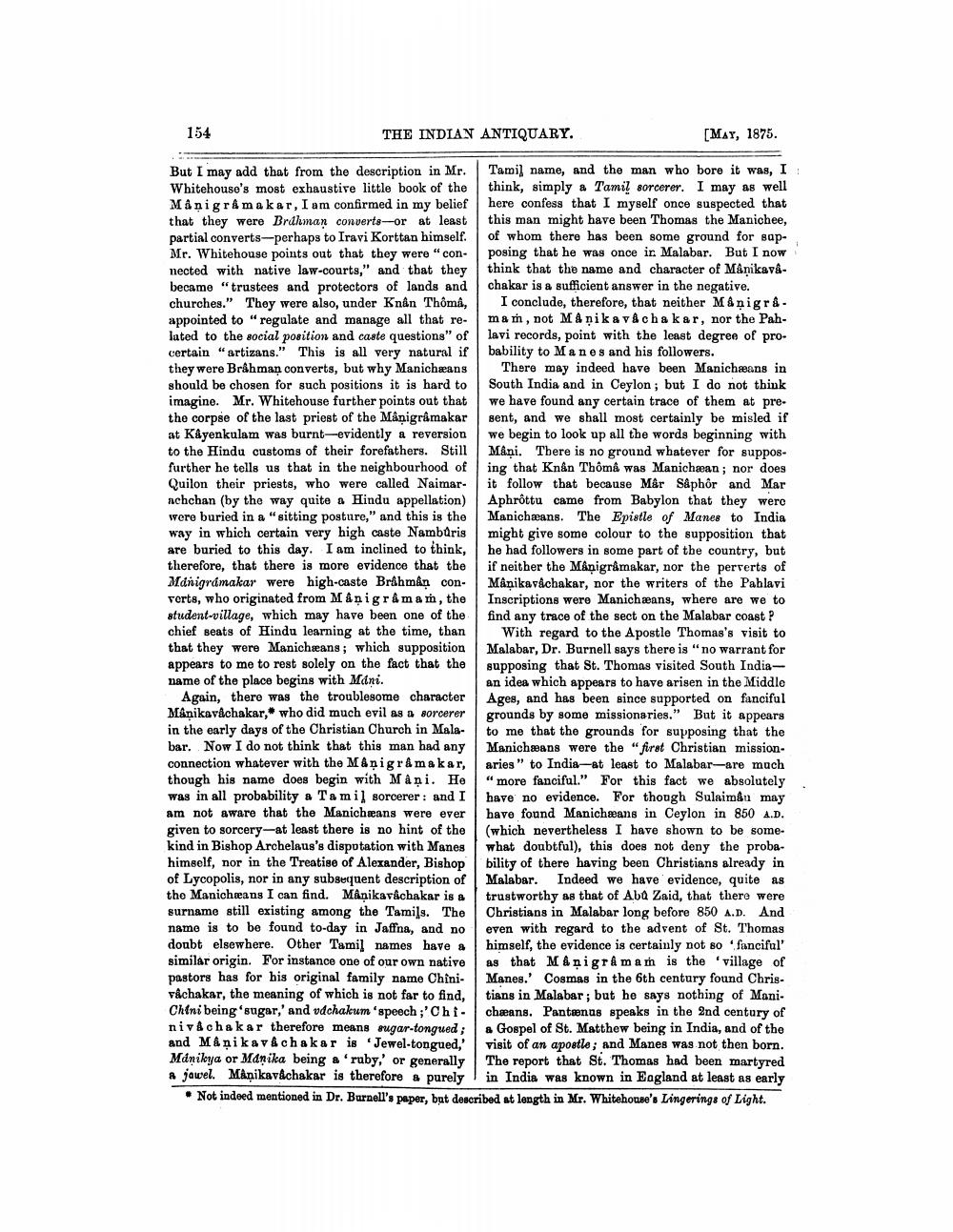________________
154
THE INDIAN ANTIQUARY.
[MAY, 1875.
Tamil name, and the man who bore it was, I think, simply a Tamil sorcerer. I may as well here confess that I myself once suspected that this man might have been Thomas the Manichee, of whom there has been some ground for sapposing that he was once in Malabar. But I now think that the name and character of Manikavachakar is a sufficient answer in the negative.
I conclude, therefore, that neither Månigra. mam, not Manikavachakar, nor the Pahlavi records, point with the least degree of probability to Manes and his followers.
But I may add that from the description in Mr. Whitehouse's most exhaustive little book of the Manigramakar, I am confirmed in my belief that they were Brahman converts—or at least partial converts-perhaps to Iravi Korttan himself. Mr. Whitehouse points out that they were "connected with native law-courts," and that they became "trustees and protectors of lands and churches." They were also, under Knân Thômâ, appointed to "regulate and manage all that related to the social position and caste questions" of certain "artizans." This is all very natural if they were Brahman converts, but why Manichæans should be chosen for such positions it is hard to imagine. Mr. Whitehouse further points out that the corpse of the last priest of the Mânigrâmakar at Kayenkulam was burnt-evidently a reversion to the Hindu customs of their forefathers. Still further he tells us that in the neighbourhood of Quilon their priests, who were called Naimarachchan (by the way quite a Hindu appellation) were buried in a "sitting posture," and this is the way in which certain very high caste Namburis are buried to this day. I am inclined to think, therefore, that there is more evidence that the Manigramakar were high-caste Brahmân converts, who originated from Manigramam, the student-village, which may have been one of the chief seats of Hindu learning at the time, than that they were Manichæans; which supposition appears to me to rest solely on the fact that the name of the place begins with Mani.
Again, there was the troublesome character Manikavachakar, who did much evil as a sorcerer in the early days of the Christian Church in Malabar. Now I do not think that this man had any connection whatever with the Manigramakar, though his name does begin with Mani. He was in all probability a Tamil sorcerer: and I am not aware that the Manichæans were ever given to sorcery-at least there is no hint of the kind in Bishop Archelaus's disputation with Manes himself, nor in the Treatise of Alexander, Bishop of Lycopolis, nor in any subsequent description of the Manichæans I can find. Mânikavâchakar is a surname still existing among the Tamils. The name is to be found to-day in Jaffna, and no doubt elsewhere. Other Tamil names have a similar origin. For instance one of our own native pastors has for his original family name Chinivachakar, the meaning of which is not far to find, Chini being 'sugar,' and vdchakum 'speech;' Chinivåchakar therefore means sugar-tongued; and Manikavachakar is 'Jewel-tongued,' Manikya or Mánika being a 'ruby,' or generally a jawel. Manikavachakar is therefore a purely
Not indeed mentioned in Dr. Burnell's paper, but described at length in Mr. Whitehouse's Lingerings of Light.
There may indeed have been Manichæans in South India and in Ceylon; but I do not think we have found any certain trace of them at present, and we shall most certainly be misled if we begin to look up all the words beginning with Mâni. There is no ground whatever for supposing that Knân Thômâ was Manichæan; nor does it follow that because Mâr Sâphôr and Mar Aphrôttu came from Babylon that they were Manichæans. The Epistle of Manes to India. might give some colour to the supposition that he had followers in some part of the country, but if neither the Mânigrâmakar, nor the perverts of Mânikavachakar, nor the writers of the Pahlavi Inscriptions were Manichæans, where are we to find any trace of the sect on the Malabar coast?
With regard to the Apostle Thomas's visit to Malabar, Dr. Burnell says there is "no warrant for supposing that St. Thomas visited South Indiaan idea which appears to have arisen in the Middle Ages, and has been since supported on fanciful grounds by some missionaries." But it appears to me that the grounds for supposing that the Manichæans were the "first Christian missionaries" to India-at least to Malabar-are much "more fanciful." For this fact we absolutely have no evidence. For though Sulaimâu may have found Manichæans in Ceylon in 850 A.D. (which nevertheless I have shown to be somewhat doubtful), this does not deny the proba bility of there having been Christians already in Malabar. Indeed we have evidence, quite as trustworthy as that of Abu Zaid, that there were Christians in Malabar long before 850 A.D. And even with regard to the advent of St. Thomas himself, the evidence is certainly not so 'fanciful' as that Manigramam is the 'village of Manes.' Cosmas in the 6th century found Christians in Malabar; but he says nothing of Manichæans. Panteenus speaks in the 2nd century of a Gospel of St. Matthew being in India, and of the visit of an apostle; and Manes was not then born. The report that St. Thomas had been martyred in India was known in Eagland at least as early




